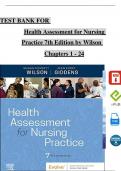Exam (elaborations)
TEST BANK For Health Assessment for Nursing Practice, 7th Edition by Wilson, All Chapters 1 - 24, Complete Newest Version
- Course
- Institution
- Book
TEST BANK For Health Assessment for Nursing Practice, 7th Edition by Wilson, Verified Chapters 1 - 24, Complete Newest Version TEST BANK For Health Assessment for Nursing Practice, 7th Edition pdf TEST BANK For Health Assessment for Nursing Practice, 7th Edition Chapters pdf Health Assessment for N...
[Show more]



